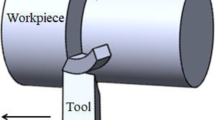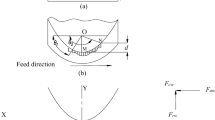Abstract
The influences of cutting parameters on temperature, stress, and shear angle during dry hard orthogonal cutting (DHOC) of D2 tool steel (62 ± 1 HRC) are investigated in this paper. Temperature and stress are considered the most important aspects to be taken into account in dry hard machining; however, dry hard machining is a complex process, and the temperature fields and residual stress are the most difficult to be measured. Up to now, only very few studies have been reported on influences of cutting parameters on shear angle, temperature, and stress of AISI D2 tool steel (62 ± 1 HRC). In this paper, the Johnson–Cook model is utilized to propose a finite element (FE) model. The FE model is properly calibrated by means of an iterative procedure based on the comparison between experimental resultant forces obtained from literatures and simulated resultant forces. At last, this FE model is utilized to predict the influences of cutting speed and depth of cut on temperature fields and residual stress within a workpiece, cutting tool edge temperature, and shear angle during DHOC hardened AISI D2 tool steel (62 ± 1 HRC) and validated by experimental results. As shown in this investigation, it is also possible to properly analyze the influences of cutting parameters on the cutting mechanism for industrial application.
Similar content being viewed by others
References
Wang JY, Liu CR (1998) A new concept for decoupling the cutting forces due to tool flank wear and chip formation in hard turning. Mach Sci Technol 2(1):77–90
Korkut I, Boy M, Karacan I, Seker U (2007) Investigation of chip-back temperature duting machining depending on cutting parameters. Mater Des 28:2329–2335
Jaspers SPFC, Dautzenberg JH, Taminiau DA (1998) Temperature measurement in orthogonai metal cutting. Int J Adv Manuf Technol 14:7–12
Ueda T, Huda MA, Yamada K, Nakayama K (1999) Temperature measurement of CBN tool in turning of high hardness steel. CIRP Ann 48(1):63–66
Tanaka R, Motishita H, Lin Y, Hosokawa A, Ueda T, Furumoto T (2009) Cutting tool edge temperature in finish hard turning of case hardened steel. Key Eng Mater 407(408):268–272
Abrao AM, Aspinwall DK (1997) Temperature evaluation of cutting tools during machining of hardened bearing steel using polycrystalline cubic boron nitride and ceramic cutting tools. J Mater Sci Technol 13:445–450
El-Wardany TI, Kishawy HA, Elbestawi MA (2000) Surface integrity of die material in high speed hard machining, Part 1: micrographical analysis. J Manuf Sci Eng 122:620–631
El-Wardany TI, Kishawy HA, Elbestawi MA (2000) Surface integrity of die material in high speed hard machining, Part 2: microhardness variations and residual stresses. J Manuf Sci Eng 122:632–641
Kishawy HA, Elbestawi MA (2001) Tool wear and surface integrity during high speed turning of hardened steel with PCBN tools. Proceedings of the Institution of Mechanical Engineering 215:755–767
Becze CE, Eng B, Eng M (2002) A thermo-mechanical force model for machining hardened steel. Dissertation, McMaster University
Mamalis G, Kundrák J, Markopoulos A et al (2008) On the finite element modeling of high speed hard turning. Int J Adv Manuf Technol 38:441–446
Shi J, Richard Liu C (2006) On predicting chip morphology and phase transformation in hard machining. Int J Adv Manuf Technol 27:645–654. doi:10.1007/s00170-004-2242-0
Paulo Davim J, Maranhão C, Faria P, Abrão A et al (2009) Precision radial turning of AISI D2 steel. Int J Adv Manuf Technol 42:842–849. doi:10.1007/s00170-008-1644-9
Stephenson DA, Jen TC, Lavine AS (1997) Cutting tool temperatures in contour turning: transient analysis and experimental verification. ASME, J Manuf Sci Eng 119(4A):494–501
Boothroyd G (1980) Fundamentals of metal machining and machine tools. In: Scripta Book Company, 3rd edn. D. C. Washington, pp 111–127
Potdar YK, Zehnder AT (2003) Measurements and simulations of temperature and deformation fields in transient metal cutting. J Manuf Sci Eng 125:645–655
Ng EG, Aspinwall DK (2002) The effect of workpiece hardness and cutting speed on the machinability of AISI H13 hot work die steel when using PCBN tooling. J Manuf Sci Eng 124:588–594
Ai X et al. (2004) High speed machining technology. In: National Defense Industry Press, 3rd edn. Beijing China, pp 36–40
Zhang XP, Zhao GW, Jiang H, Richard CR (2006) Experimental investigation on the surface integrity of hard machined components by super-finish turning. J Shanghai Jiaotong Univ 40(6):922–926
Author information
Authors and Affiliations
Corresponding author
Rights and permissions
About this article
Cite this article
Tang, L., Huang, J. & Xie, L. Finite element modeling and simulation in dry hard orthogonal cutting AISI D2 tool steel with CBN cutting tool. Int J Adv Manuf Technol 53, 1167–1181 (2011). https://doi.org/10.1007/s00170-010-2901-2
Received:
Accepted:
Published:
Issue Date:
DOI: https://doi.org/10.1007/s00170-010-2901-2




